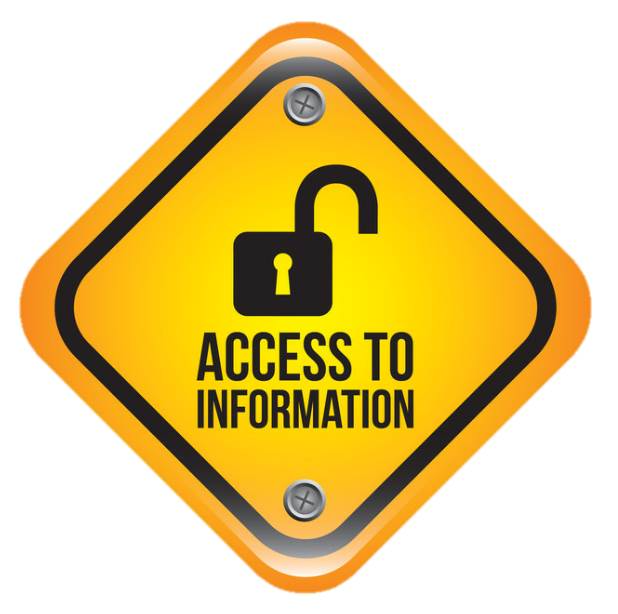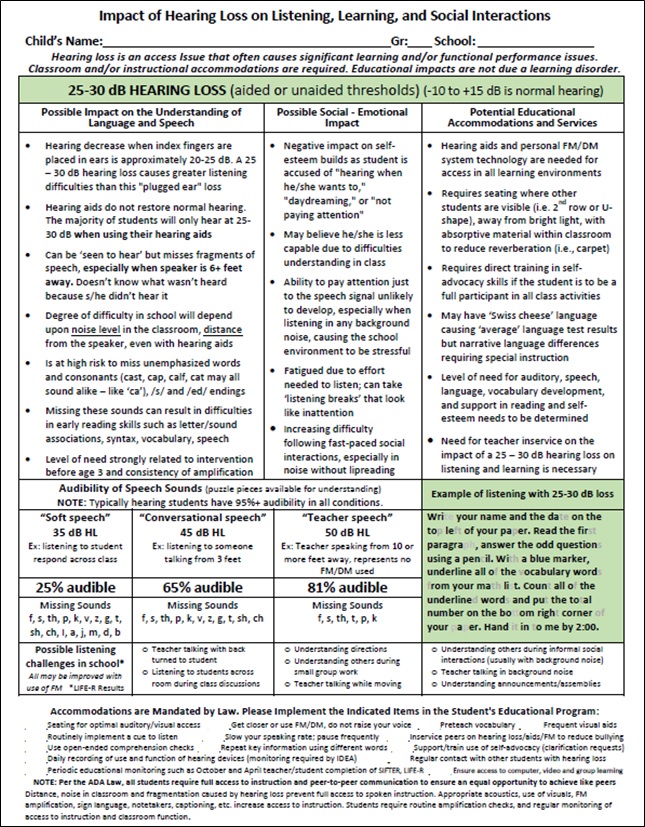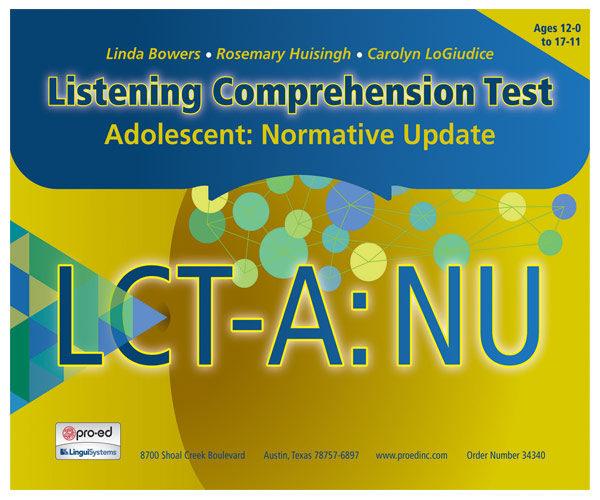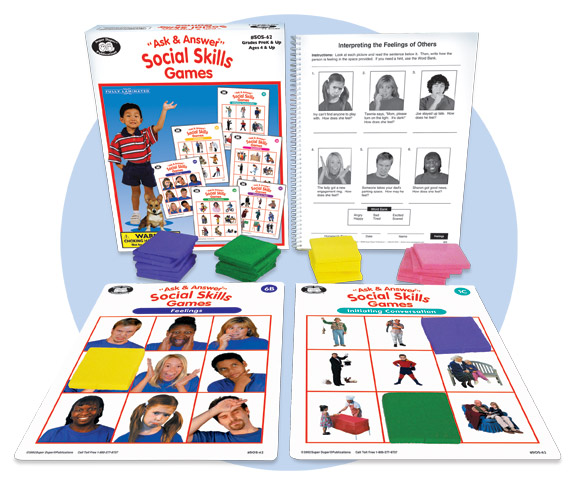Related Products
For Professionals
- Amplification
- Assessment of Student Skills, Challenges, Needs
- Early Childhood: Infants, Toddlers, Preschool
- Hearing Loss – Identification, Impact and Next Steps
- IDEA Law Summary Information
- Language and Speech Development Issues
- Legal Issues in Serving Children with Hearing Loss
- Listening (Auditory Skills) Development
- Planning to Meet Student Needs
- Self-Advocacy Skills for Students with Hearing Loss
- Self-Concept: How the Child with Hearing Loss Sees Himself
- Social Skills
- Speech Perception & Learning
Related Teacher Tools Takeout Items
Hearing Devices – Tools, Not Miracles

Unfortunately, NO hearing technology fully restores normal hearing. There is no doubt that consistently worn, modern hearing devices provide more access to speech than ever before BUT we can never assume that there will be no functional impact, even if a student seems to be performing ‘okay’ in the classroom. We can infer the impact of hearing loss on precision hearing from a student’s audiogram, but only functional measures will identify the degree to which the hearing loss actually impacts educational performance. One of our jobs is to determine just how much of an improvement occurs when student’s use personal and/or classroom hearing devices.
| Hearing loss is an access issue which reduces exposure to language, especially that occurring from beyond 3-6 feet. Noise further decreases access to speech. These access issues are most likely to impact language, speech, vocabulary, reading, self-concept and socialization. Consistent use of amplification can improve access, but speech perception will continue to be poorer than normal in school situations. |
Being closer to the person talking will help the listener with hearing loss to hear more loudly and clearly. Hearing devices amplify sound and make it seem louder and clearer at ear level for persons with hearing loss, but never ‘corrects’ hearing to a normal hearing level. Therefore, students with hearing loss have smaller ‘listening bubbles’ or shorter listening ranges than their typically hearing peers. Hearing aids and FM/DM/HAT systems do not restore normal hearing, but they DO provide much improved access to verbal communication that would otherwise be auditorily impossible to the child with hearing loss.
Focused Consideration of Access Needs

Universally, students with hearing loss have greater difficulty accessing verbal communication in both large and small group instruction within the typical classroom environment. It is not a question of IF a student needs accommodation, it is a question of verifying WHEN, under what conditions, WHICH accommodations are necessary to level the access playing field. Schools are required1 to ensure that communication for students who are deaf or hard of hearing is as effective as communication for others to afford an equal opportunity to reach the same level of achievement as that provided to others. Functional hearing is necessary to identify and cannot be revealed by an audiogram or speech and language evaluation. Refer to the White Paper on Estimating Access and the Cascading Impact handout for more information.
Gathering functional information about educational performance is every bit as important as considering academic performance2. The communication access issues of our students require them to work harder, expending more energy, often to receive less information than their typically hearing peers. An audiogram informs us of access in a quiet setting but cannot provide sufficient information about the educational impact of hearing loss. Functional performance issues require appropriate access accommodations. They may also warrant instruction in self-advocacy skills, social interaction, or other aspects of the Expanded Core Curriculum that need specific and direct teaching.
When considering the impact of hearing loss and trying to help others to understand it, we can think about it in two ways: impact on precision hearing and impact on functional performance.

Precision hearing can be inferred from audiometric information. The Speech Audibility Audiogram for Classroom Listening represents speech audibility for 35 dB HL (soft speech) and 50 dB HL (louder than conversational level speech) inputs and is based on the figure shown left. It represents 5 dB bands of hearing levels (i.e., 20-25 dB). You can consider a student’s hearing thresholds with hearing aids and also without hearing aids. This tool is most applicable to flat configurations of hearing loss. Audibility means the speech energy that is available for a student to figure out what was said. Think of it as having 100 puzzle pieces if you have normal hearing, and therefore normal audibility. If a student has aided hearing in the 25- 30 dB range he would have only 25% audibility for soft speech (like hearing a classmate answer a question from across the room) and 81% audibility for teacher speech, especially when the teacher is further than 6 feet away. Using this tool helps to make the point that a student can ‘hear’ but not receive all of the information necessary for comprehension, especially unfamiliar information. The information from the Speech Audibility Audiogram has been converted to teacher inservice handouts representing how speech perception is typically effected when hearing aids or cochlear implants are used. See the Impact of Hearing Loss on Listening, Learning and Social Interactions handouts. They include typically missing speech sounds at classroom distances.
We can also identify precision hearing systematically to identify the speech sounds that are challenging for the student to hear consistently. One tool that can be used is the Iowa Medial Consonant Test that presents the student with consonant sounds in a format like ee-x-ee or aa-x-aa (like ee-pee, ee-tee). If a child has a hearing loss between 26-70dB, optimally fit hearing aids and has had some attention to auditory development then he should be able to score 100% on this test from 3 feet without visual cues. It can be performed with ee-x-ee at 3 feet and aax-aa at 10 feet so you can compare the difference in speech perception.
|
Example: Sally is able to respond only to the loudest and lowest pitch sounds (oo, ee, aw, m, sh) in quiet. Although she may be able to detect speech at 6 feet in noise, the signal is not clear enough for consistent understanding. At further teaching distances (i.e., 10-15 feet), Sally’s ability to detect to any of the sounds was very inconsistent. Thus, her “listening bubble” for optimal speech perception, and therefore language learning, is from 1-3 feet in quiet or noise. |
Precision hearing can also be determined by eliciting the Ling sounds at different distances. The discovery process defined in the Early Listening Function checklist has been revised using Ling Sounds. To complete the ELFLing checklist the teacher would say the Ling sounds starting from 15 feet away from the student, who would repeat the sounds heard. The teacher would then move to 10 feet and repeat the Ling sounds, then 6 and 3 and finally 1 foot if there are still sounds that the child has been unable to consistently repeat. Typically it becomes evident that the louder vowel sounds can be detected consistently from a much further distance than the sh/ch and especially the s/th sounds. It is important to repeat the ELFLing in the presence of low background noise to show how detrimental background noise is to precision listening.
Norm-Referenced Option – Functional listening is also critical to determine. An audiogram informs us of access but cannot provide information about the educational impact of hearing loss. We can infer the impact on precision hearing, but only functional measures will identify the degree to which the hearing loss is actually impacting educational performance. We now have a norm-referenced instrument to obtain information about both precision listening and some information about functional listening. The Developmental Test of Auditory Perception (DTAP) is appropriate for ages 6-18 years and has 5 subtests with language-based and nonlanguage-based items. The normative sample provides a strong basis to show that our students can have adverse educational performance issues.
Impact on Functional Performance. The Functional Listening Evaluation is a MUST to perform on every student with hearing loss! With the clarification of ADA clearly requiring every child with hearing loss to be ensured equally effective communication as their peers, it is necessary to determine just how effective a student’s ability to perceive speech really is under various conditions. We no longer have the luxury of performing the FLE “when I have time” or “only when asked.” The Recorded FLE has been designed to simplify the process for obtaining this information quickly and easily. With practice, performing the FLE should take only about 15-20 minutes. It also can be an important learning tool for students to better understand their own hearing loss and listening challenges.
Another assessment of functional performance using hearing in the classroom is the Listening Inventory For Education – Revised Student Appraisal continues to be one of the most effective means to gain information from students to identify and quantify their listening challenges. If you have not heard of the LIFE-R or taken time to try it, do so this year! It will change how you write goals for self-advocacy and how you inservice teachers! The LIFE-R is available FREE in a format you can complete with students online. Fillable version of the LIFE-R checklists (student appraisal, teacher appraisal, before LIFE, after LIFE, with photos) are on Takeout.
In summary, the job of hearing devices is to improve the audibility of speech, allowing students to perceive much more of verbal instruction and all other spoken communication more fully. By funneling more audible speech information into the brain, the student is able to access more of the curriculum. For our hard of hearing students, hearing devices can be considered the gateway to their educational and social success. For the impact of hearing loss to be minimized optimally, students who are hard of hearing need well fit hearing aids or implants, the devices need to function appropriately, and the student needs to be willing to use the devices in school, and preferably all waking hours.

Invest the time to identify a child’s level of access to speech under typical school conditions. There is no replacement for the critical information obtained by doing a Functional Listening Evaluation. Students with typical hearing score 95%+ in quiet and 90%+ in noise. If a student has been trained to routinely respond to Ling sound audibility checks, take the time to perform the ELFLing, which systematically identifies the ability to perceive the Ling sounds at different distances. If you only have a few minutes, at least do the Iowa Medial Consonant Test, which is a fast check of audibility for specific consonant sounds. If a child has 25-70 dB hearing levels and has worn hearing aids for some time, then a 100% score is expected.
Hearing aids should be fit so that students with hearing loss of 25-70 dB can perceive all of the speech phonemes in quiet from 3 feet without watching the speaker’s face. If you have a student who does not seem to be able to do this, bring the issue to the attention of the family and audiologist. If hearing devices are the gateway to learning, removing any barrier to that gateway can only benefit the student’s performance.
References
- Summary of ADA information related to students with hearing loss.
- IDEA Eligibility Determination – Section 300.304(b)(1)



